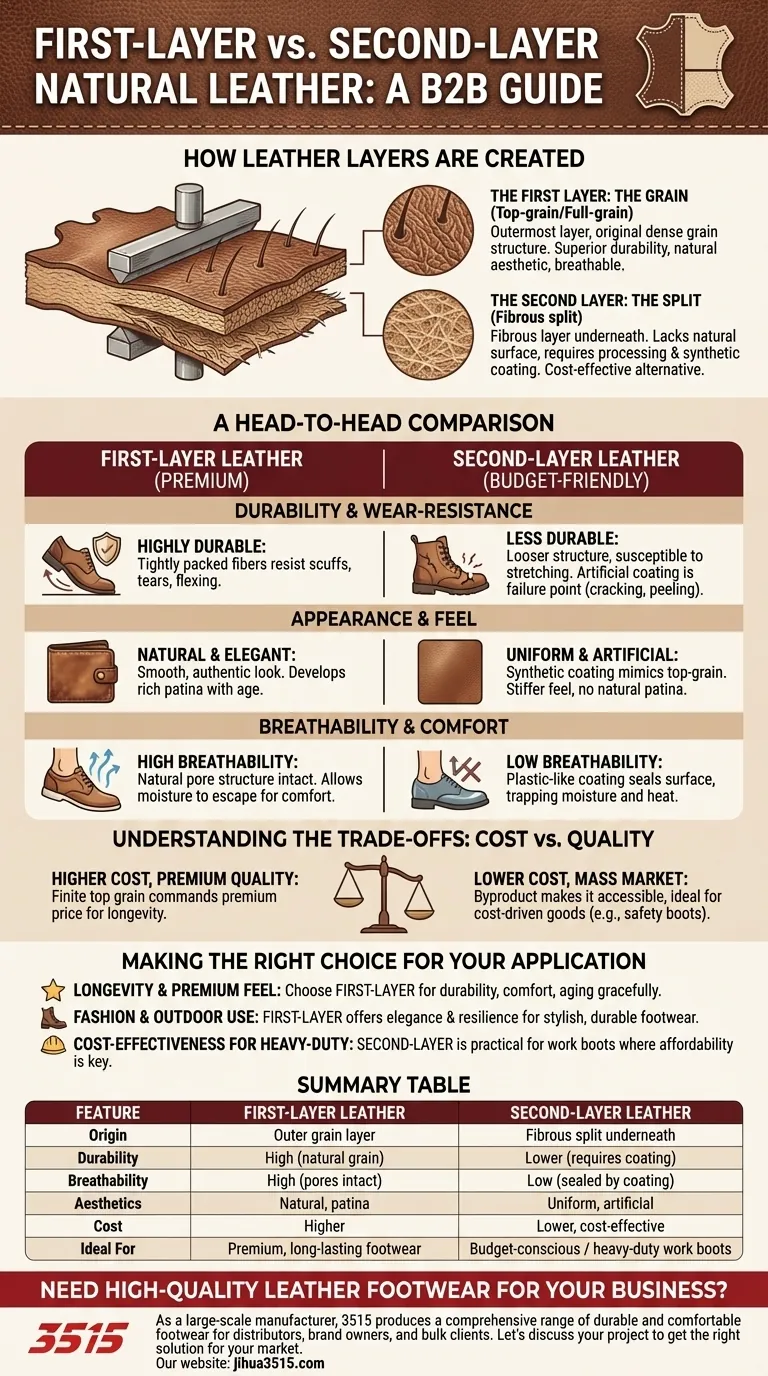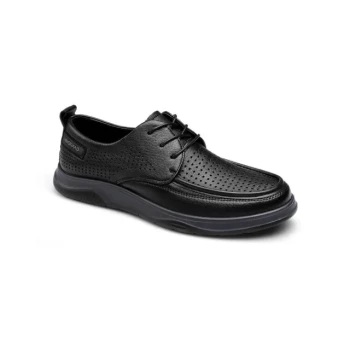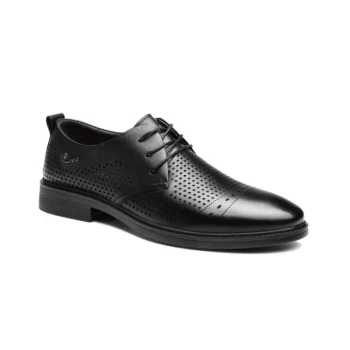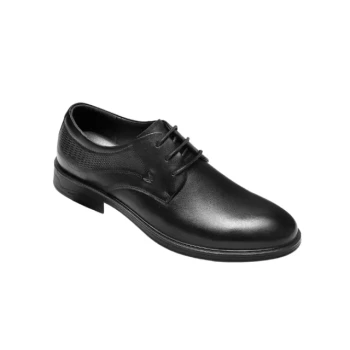The fundamental difference between first-layer and second-layer leather lies in their origin from the animal hide. First-layer leather, also known as top-grain or full-grain, is the outermost layer with the original, dense grain structure intact. Second-layer leather is the fibrous split from underneath, which lacks the natural surface and requires more processing.
The core distinction is simple: First-layer leather offers superior durability and a natural aesthetic due to its original grain, while second-layer leather provides a cost-effective alternative by utilizing the remaining fibrous part of the hide.

How Leather Layers Are Created
To understand the difference in quality, you first need to understand how a thick animal hide is processed. A single hide is often too thick for most applications, so it is split horizontally into two or more layers.
The First Layer: The Grain
The first-layer is the prized top cut of the hide. It contains the original outer surface, or grain, which is the densest and most durable part of the leather.
This layer is valued for its natural texture, breathability, and strength. It directly reflects the life of the animal, sometimes showing minor imperfections that are considered marks of authenticity.
The Second Layer: The Split
The second-layer, often called "split leather," is the fibrous layer that remains after the top grain has been removed. It has a rougher, more suede-like texture on both sides.
Because it lacks the tight, durable grain surface of the first layer, it must be processed further. It is often coated with a synthetic finish or polymer to create an artificial surface that mimics the appearance of top-grain leather.
A Head-to-Head Comparison
Each layer has distinct properties that make it suitable for different applications. The choice between them is a direct trade-off between performance and cost.
Durability and Wear-Resistance
First-layer leather is significantly more durable and wear-resistant. The tightly packed fibers of the natural grain provide excellent resistance to scuffs, tears, and flexing over time.
Second-layer leather is inherently less durable. Its looser fibrous structure makes it more susceptible to stretching and damage. The artificial coating applied to it is often the first point of failure, prone to cracking or peeling with heavy use.
Appearance and Feel
The natural grain gives first-layer leather a smooth, elegant, and authentic appearance. It develops a rich patina as it ages, enhancing its character.
Second-layer leather has a more uniform, artificial look due to its synthetic coating. It feels stiffer and less "buttery" than top-grain leather and does not develop a natural patina over time.
Breathability and Comfort
First-layer leather is highly breathable because the natural pore structure of the grain remains intact. This makes it more comfortable for items like shoes and upholstery, as it allows moisture to escape.
Second-layer leather is significantly less breathable. The plastic-like coating applied to its surface seals the material, trapping moisture and heat.
Understanding the Trade-offs: Cost vs. Quality
The most significant advantage of second-layer leather is its lower cost, which makes it a popular choice for budget-conscious products. However, this comes with clear compromises.
The Reason for the Price Gap
The top grain is a finite, high-demand portion of the hide, making first-layer leather inherently more expensive. Its superior longevity and aesthetic qualities command a premium price.
Second-layer leather is essentially a byproduct of creating first-layer leather. Its lower cost makes it an accessible material for mass-market goods, such as work boots for construction, where price is a primary driver.
The Impact of Coatings
Be aware that many products made from second-layer leather are finished to look almost identical to genuine top-grain leather at first glance. This coating is the key weakness, as it lacks the durability of a natural grain and can degrade quickly.
This is why a brand-new pair of budget leather shoes might look great but start to crack and peel after only a few months of wear, while a quality pair made from first-layer leather can last for years with proper care.
Making the Right Choice for Your Application
Your final decision should be based entirely on your priorities for the product.
- If your primary focus is longevity and premium feel: Always choose first-layer leather for its durability, comfort, and ability to age gracefully.
- If your primary focus is fashion and appearance for outdoor use: First-layer leather offers the ideal blend of elegance and resilience needed for stylish, durable footwear.
- If your primary focus is cost-effectiveness for heavy-duty use: Second-layer leather is a practical choice for applications like construction safety shoes, where affordability outweighs the need for a perfect finish.
Ultimately, understanding the source of the leather empowers you to choose the right material for your purpose and budget.
Summary Table:
| Feature | First-Layer Leather | Second-Layer Leather |
|---|---|---|
| Origin | Outer grain layer of the hide | Fibrous split underneath the grain |
| Durability | High (natural grain structure) | Lower (requires synthetic coating) |
| Breathability | High (natural pores intact) | Low (sealed by coating) |
| Aesthetics | Natural, develops a patina | Uniform, artificial look |
| Cost | Higher | Lower, cost-effective |
| Ideal For | Premium, long-lasting footwear | Budget-conscious or heavy-duty work boots |
Need High-Quality Leather Footwear for Your Business?
As a large-scale manufacturer, 3515 produces a comprehensive range of durable and comfortable footwear for distributors, brand owners, and bulk clients. Whether your priority is the superior longevity of first-layer leather or the cost-effectiveness of second-layer leather for work boots, we have the production capabilities to meet your needs.
Let’s discuss your project: Contact our team today to get the right footwear solution for your market.
Visual Guide

Related Products
- Wholesale Leather Business Casual Shoes with Dial Closure - Manufacturer of Comfort Dress Sneakers
- Wholesale Leather Derby Shoes Manufacturer | Customizable Business & Dress Footwear
- Classic Leather Derby Dress Shoes Wholesale & Custom Manufacturing
- Custom Manufactured Air Cushion Leather Business Shoes for Wholesale
- Factory Direct Wholesale Leather Comfort Shoes with Dial Closure
People Also Ask
- What should be known about genuine leather for shoes? Don't Be Misled by the Label
- What are the main categories of shoe materials? A Guide to Leather, Knit, Canvas & More
- What are the key features of high-quality leather in shoes? Invest in Durability and a Perfect Fit
- How should business casual shoes be maintained? A Proactive System for Longevity & Style
- How often should business casual shoes be rotated? Maximize Longevity with Proper Care



















